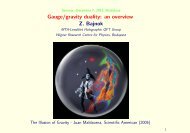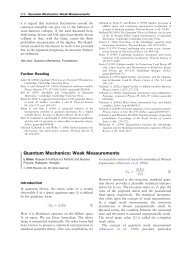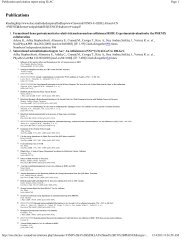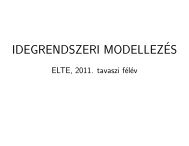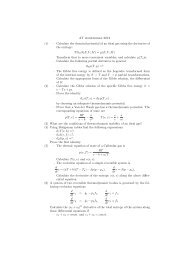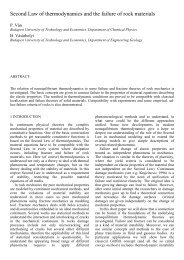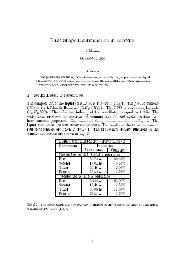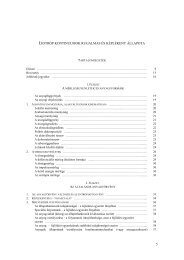hungarian scientists in the us - Columbia University
hungarian scientists in the us - Columbia University
hungarian scientists in the us - Columbia University
You also want an ePaper? Increase the reach of your titles
YUMPU automatically turns print PDFs into web optimized ePapers that Google loves.
György Buzsáki<br />
traces dur<strong>in</strong>g sleep. His recent book<br />
“Rhythms of <strong>the</strong> Bra<strong>in</strong>” is masterful<br />
account of how cortical cells and<br />
circuits give rise to higher cognitive<br />
functions. Dr. Buzsáki is among <strong>the</strong><br />
top 150 most-cited neuro<strong>scientists</strong>, a<br />
Fellow of <strong>the</strong> American Association<br />
for <strong>the</strong> Advancement of Science, foreign<br />
member of <strong>the</strong> Hungarian Academy<br />
of Sciences, and sits on <strong>the</strong> editorial<br />
boards of several lead<strong>in</strong>g journals,<br />
<strong>in</strong>clud<strong>in</strong>g Science and Neuron.<br />
Awards and Named Lectures<br />
The Bra<strong>in</strong> Prize (2011), Honors Lecture.<br />
New York <strong>University</strong> (2011),<br />
Keynote Speaker, European College<br />
of Neuropsychopharmacology<br />
(2010), The Talairach Lecture, Organization<br />
of Human Bra<strong>in</strong> Mapp<strong>in</strong>g<br />
Society (2010), Grass Travel<strong>in</strong>g Scientist<br />
(1992; 2009), The Hans-Lucas<br />
Teuber Lecture, MIT (2009), The David<br />
Smith Lecture, Oxford <strong>University</strong><br />
(2009), H. Neufeld Memorial Award,<br />
Israel (2008), Open<strong>in</strong>g Plenary Lecture,<br />
Federation of European Neuroscience<br />
Societies (2006), Elected Associate,<br />
Neuroscience Research Program<br />
(2006), Elected Fellow, AAAS<br />
(2004), Krieg Cortical Discoverer<br />
Award (2001) Dist<strong>in</strong>guished Lecturer,<br />
Collége de France (1998, 2008),<br />
The first Pierre Gloor Award (1997),<br />
The Moruzzi Lecture. European Neuroscience<br />
Association (1996).<br />
Neural syntax and cognition<br />
The traditional approach <strong>in</strong> understand<strong>in</strong>g<br />
bra<strong>in</strong> function is to give simple<br />
<strong>the</strong>n more complex stimuli to <strong>the</strong><br />
bra<strong>in</strong> and see what happens. I call this<br />
<strong>the</strong> ‘empiricist’ approach beca<strong>us</strong>e it<br />
assumes that <strong>the</strong> bra<strong>in</strong> faithfully represents<br />
<strong>the</strong> world out <strong>the</strong>re. This method<br />
is a bit like learn<strong>in</strong>g words of a foreign<br />
language, j<strong>us</strong>t collect<strong>in</strong>g correspondences.<br />
The <strong>in</strong>itial progress is fast; one<br />
can get by <strong>in</strong> Hungary with j<strong>us</strong>t 100<br />
words of vocabulary. However, when<br />
it comes to truly understand<strong>in</strong>g a language<br />
such as hieroglyphs or <strong>the</strong> language<br />
of <strong>the</strong> bra<strong>in</strong> (where we do not<br />
even know what is to be understood),<br />
we need to know about <strong>the</strong> grammar,<br />
that is how <strong>in</strong>formation is segmented<br />
György Buzsáki graduated as an MD<br />
from <strong>the</strong> <strong>University</strong> of Pécs, Hungary<br />
<strong>in</strong> 1974 and received his Ph.D. <strong>in</strong> Neuroscience<br />
from <strong>the</strong> Academy of Sciences,<br />
Budapest <strong>in</strong> 1984. Currently,<br />
he is a Board of Governors Professor<br />
of Neuroscience at Rutgers <strong>University</strong>,<br />
Newark, NJ.<br />
Over <strong>the</strong> past 35 years György Buzsáki<br />
has led <strong>the</strong> way <strong>in</strong> analyz<strong>in</strong>g how<br />
neuronal circuits code, transfer and<br />
store <strong>in</strong>formation, especially how different<br />
bra<strong>in</strong> oscillations serve such<br />
mechanisms. He pioneered <strong>the</strong> experimental<br />
exploration of how coord<strong>in</strong>ated,<br />
rhythmic neuronal activity<br />
serves physiological functions <strong>in</strong> <strong>the</strong><br />
cerebral cortex, and <strong>in</strong> particular, how<br />
<strong>in</strong>formation is exchanged between<br />
<strong>the</strong> hippocamp<strong>us</strong> and neocortex. His<br />
most <strong>in</strong>fluential work, <strong>the</strong> two-stage<br />
model of memory trace consolidation,<br />
demonstrates how <strong>the</strong> neocortexmediated<br />
<strong>in</strong>formation dur<strong>in</strong>g learn<strong>in</strong>g<br />
transiently modifies hippocampal<br />
networks, followed by reactivation<br />
and consolidation of <strong>the</strong>se memory<br />
3624124 23 24<br />
or packaged <strong>in</strong>to words and sentences.<br />
The goal of my lab is to reveal neuronal<br />
syntax or bra<strong>in</strong> grammar. As <strong>in</strong> language<br />
and m<strong>us</strong>ic, <strong>the</strong> tempo, punctuation<br />
etc., are essential, <strong>the</strong> same applies<br />
to <strong>the</strong> bra<strong>in</strong>. In neuronal networks,<br />
especially <strong>in</strong> those structures that serve<br />
cognitive functions, <strong>the</strong> packag<strong>in</strong>g of<br />
<strong>in</strong>formation and segmentation is supported<br />
by <strong>the</strong> numero<strong>us</strong> rhythms <strong>the</strong><br />
bra<strong>in</strong> generates. These rhythms, aga<strong>in</strong><br />
like <strong>in</strong> m<strong>us</strong>ic, provide temporal correlations<br />
at multiple time scales, which can<br />
be ma<strong>the</strong>matically def<strong>in</strong>ed. In <strong>the</strong>se<br />
rhythms, <strong>in</strong>hibitory processes play an<br />
essential role. I will demonstrate how<br />
this process may work <strong>in</strong> stor<strong>in</strong>g and<br />
recall<strong>in</strong>g memories.<br />
Electrical field generated by a s<strong>in</strong>gle neuron.<br />
Legend: Genetic eng<strong>in</strong>eer<strong>in</strong>g of <strong>the</strong> mo<strong>us</strong>e bra<strong>in</strong> allows <strong>in</strong>vestigators to address novel hypo<strong>the</strong>ses.<br />
In this cute mo<strong>us</strong>e, electrical junctions between neurons were knocked out genetically<br />
by <strong>in</strong>activat<strong>in</strong>g <strong>the</strong> responsible gap junction prote<strong>in</strong>. As a result, both hippocampal electrical<br />
patterns, especially gamma frequency oscillations (40–100 Hz), and memory were impaired.<br />
(Buzsaki et al., Neuroscience 2003). (Art: G. Buzsaki; electrical traces superimposed on microphotograph<br />
of silver sta<strong>in</strong>ed section of <strong>the</strong> hippocamp<strong>us</strong> and gene structure).



